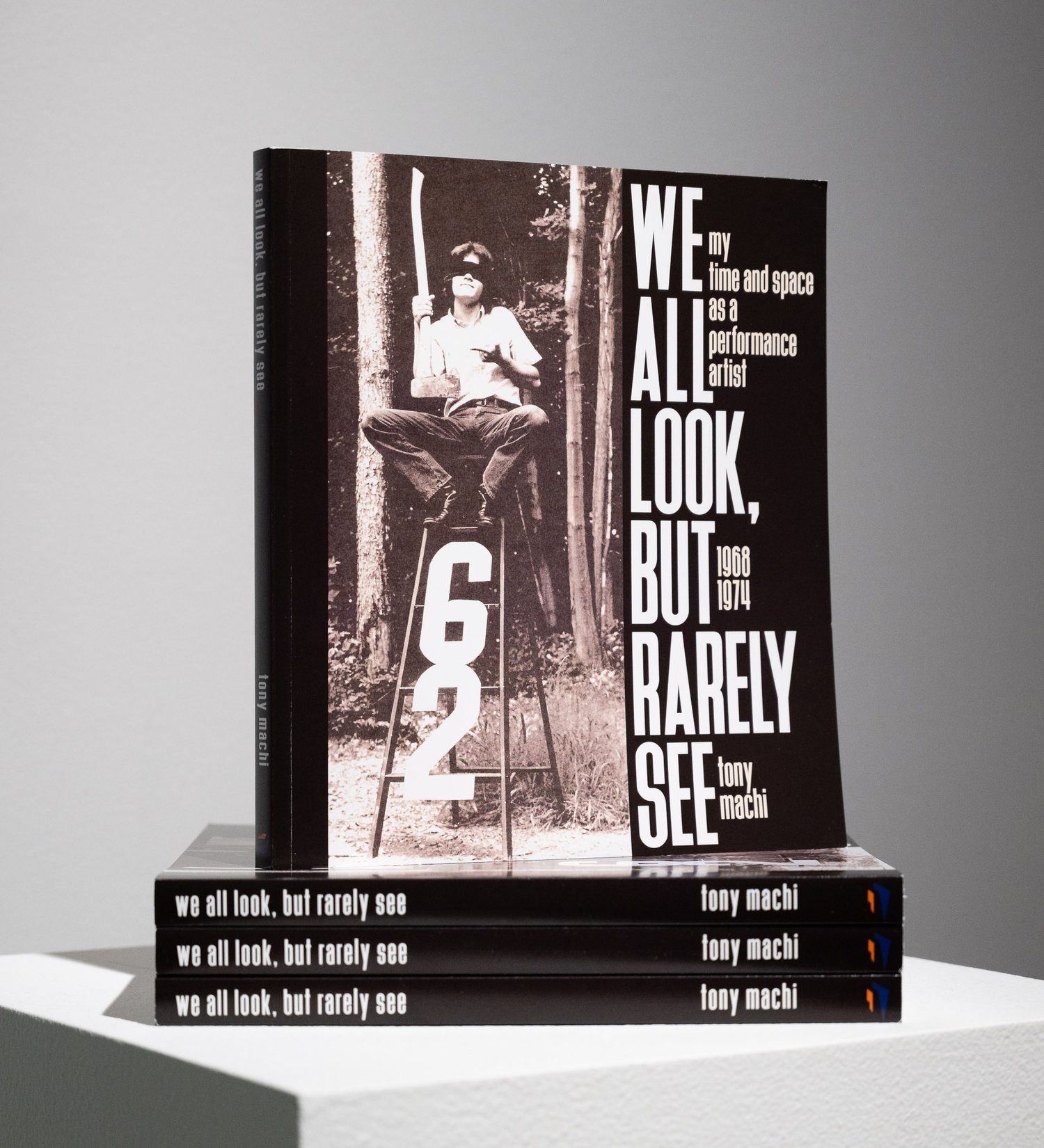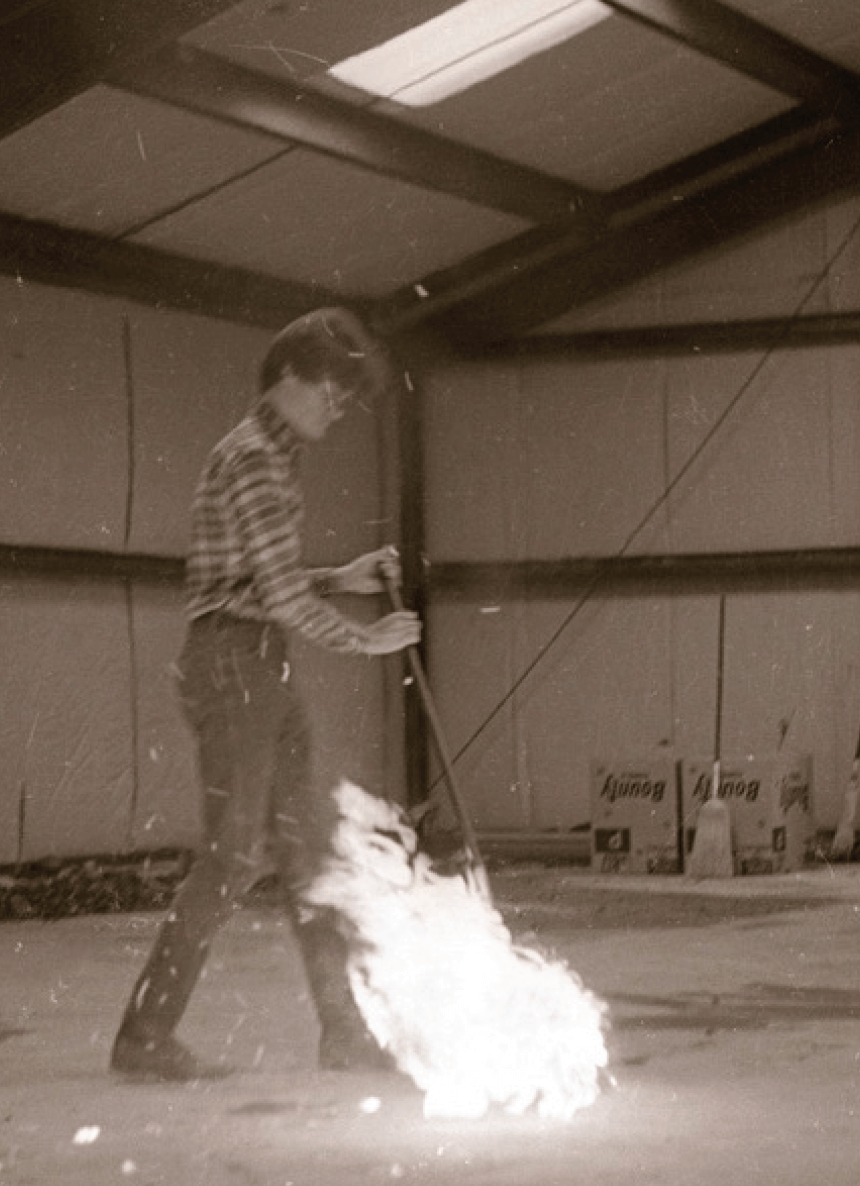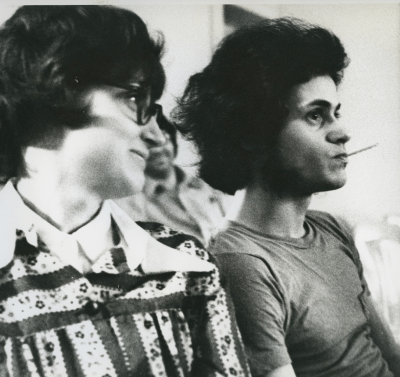We All Look, But Rarely See: An Exclusive First Look
Tony Machi's new memoir connects Edinboro with national counterculture art movement
From afar, Tony Machi's new book We All Look, But Rarely See: My Time and Space as a Performance Artist, covers familiar ground: the 1960s and 1970s art movements and their countercultural leanings. But, when you actually crack open the beautifully-designed, 239-page coffee table experience, you'll find that influential period is filtered through an intimate and regional lens. You see, Machi (an award-winning multimedia artist and documentarian) presents something that's part memoir and part art history, the latter covering major figures (Andy Warhol) and potential blind spots (Black Mountain College) with equal enthusiasm and insight. Meanwhile, the memoir portion takes you from his artistic origins in Pittsburgh, to his time at Edinboro State College and his mentors, to his exciting and experimental work with WQLN and PBS. All in all, you get a reading experience perfect for both the art buff and, really, anyone that likes a good coming-of-age story.
Exclusive to the Erie Reader comes the entirety of Chapter 11 from We All Look, But Rarely See, a section that takes place in the late 1960s. Most importantly, this chapter includes an exploration of performance art, a medium that Machi engaged with in its infancy, presenting several experiential pieces to the Edinboro student body (a student body that reacted both positively and negatively to Machi's creativity). At this stage in the book, Machi had already presented a few of his earliest performance art pieces to the 'Boro, but was honing his approach. As Machi writes at one point: "My intent was to afford my audience an opportunity to zero in on the moment and ask themselves, 'What exactly did I just experience?' and 'How is it art?' with my hope for an aesthetic response, followed by a lingering memory of the performance."
 We All Look, But Rarely See is currently available at the Erie Art Museum. While there, you can also check out Machi's new exhibit, "Passionately Curious," which is being held in the Customs House.
We All Look, But Rarely See is currently available at the Erie Art Museum. While there, you can also check out Machi's new exhibit, "Passionately Curious," which is being held in the Customs House.
We All Look, But Rarely See is currently available for purchase at both the PennWest Edinboro University bookstore and at the gift shop at the Erie Art Museum. Proceeds from book sales will go toward the creation of an art scholarship at PennWest Edinboro.
Accompanying the book release, Machi also has an exhibit at the Erie Art Museum, titled "Passionately Curious." Along with his own work, the exhibit features several pieces from his primary inspirations, including a Warhol original. Machi will be at the exhibit on Friday, June 23 as part of the citywide Gallery Night. He'll be meeting readers and signing books.
Enjoy this sneak preview of We All Look, But Rarely See: My Time and Space as a Performance Artist
Chapter 11
I was no longer a stranger in a strange land. I had found what I was looking for, and it was time to remake myself. With Jim for my immediate mentor and Marcel Duchamp for my patron saint, I had self-educated to the point of now having a personal philosophy. After internalizing the work of many others, both past and present, I needed to follow a direction of my own making. This is how a street kid from Pittsburgh and a senior in high school with the skimpiest knowledge of Michelangelo, only three years later leapt into an art movement as radical as performance art.
With a backhanded association with conventional entertainment and the highest purpose as no purpose at all, my performances would have little to do with convention. Nor would they be akin to the unconventional theater of the Theatre of the Absurd or Antonin Artaud's Theatre of Cruelty. Shock for the sake of being shocking did not interest me, nor did being political. I believed the generally accepted principles underlying performance art were shocking enough. Incorporating elements such as nudity, violence, or politics for that matter, forced an unnecessary focus. I've always been more interested in subtlety than being outwardly obvious, anyway. For me, less — in almost every case — was more. (Originally found in an 1855 poem by Robert Browning, "less is more" is more commonly associated with architect Ludwig Mies van der Rohe for his belief in a simplicity of style).
In an attempt to free myself from storytelling, I increasingly avoided making parallel connections. When I conceived a performance, I chose dissimilar elements, both conceptually and materially at random. I also rarely titled my performances in a further attempt to avoid meaning. Without a plot, I intentionally avoided any kind of denouement. In other words, my performances were not explicitly "about" anything. In film, Alfred Hitchcock used a device he called a "MacGuffin" — a device that moved the plot forward but was itself insignificant or irrelevant. My performances were largely MacGuffins, important for being unimportant. A pipe dream, a chimera? Obviously! It is natural that we intuit patterns of order. As Homo sapiens, we are hard-wired to find meaning in everything, to connect the dots, even when confronted with obscurity or abstraction. Nevertheless, by steering clear of "story," I commingled the art world with the real world and let the audience determine what they had just experienced —to derive meaning, or no meaning at all. Waiting for Godot may be a play about nothing, but it is still theater, chock full of metaphor and symbolism, with a beginning, middle and end. My performances were not theater, but more like life itself. Experiential.
I largely avoided the use of language in my performances too; monologue and dialogue were for real theater. Once I randomly chose the word "principality" by chance from the dictionary to use in a performance. The audience was instructed to repeat the word in unison for the entire performance, thus making the word meaningless, as in a meditation. I also avoided using pre-recorded music, allowing the natural sounds of the physical space, myself, and the audience to be the soundtrack of the performance.
Altering the conventional definition of "audience" became an important element in my work. For a time, Jim and I staged our performances in the new concrete and aluminum "sculpture annex" at Edinboro, before it was utilized as a studio. The space was a large empty rectangle, perfect for staging performances. Usually, we'd ask people to stand wherever they wished for the duration. Whether they realized it or not, this blurred the line between them and us and made them integral to the performances just by their presence. I especially liked to line people along the walls. This not only helped define the space but also gave everyone a slightly different vantage point. When Jim and I were offered a conventional stage, it gave me the opportunity to intentionally break the wall (known in theater as the fourth wall) between the audience and myself by leaving the stage to perform among the audience. In the middle of one performance, I left the stage and sat with the audience. I retrieved a thermometer from a breast pocket and took my temperature. After a minute I read the thermometer, gave it to the person beside me, returned to the stage and continued as though the performance never stopped... because it hadn't. Even when seated in a conventional theater, I controlled where the audience would sit. Sometimes I'd separate the audience into groups and put them in different spaces, so that each group would experience only part of the whole performance, forcing them afterwards to seek anyone who would tell them what they missed. At one venue, the audience was instructed to choose between witnessing me outdoors in a park, or staying indoors to watch a film. Only after the two concluded did anyone realize that both parts were about the same park and were the same performance. I once staged a performance in an immense dining hall filled with large round tables and chairs; one audience member per table. Above the audience, along a long wall, were large rectangular glass windows the length of the wall. Midway through the performance, the audience was instructed to put paper bags over their heads. Performers then appeared in the windows to pose, move and make sounds behind the glass, leaving the audience to choose between sitting patiently, or removing their bags to see what was happening.

In this 1969 performance art piece, Machi swept the floor to "define the space," while then lighting the broom on fire to sweep the floor again. Photo: contributed.
Concerning Pop Art, Andy Warhol once said, "The artist's job was not to offer up new images of beauty, but to reproduce what society had already approved." What I performed or had others perform had nothing to do with generally accepted notions of conventional beauty or a specialized skill, for that matter. "Things to perform" were mostly mundane, every day, and/or absurdist activities like walking, running, kneeling, shaving my face, washing my hair, throwing marshmallows in the air. In 1969 in the Edinboro sculpture annex, I swept the concrete floor with a broom to define the space. Then I lit the broom on fire and swept the exact space again. In 1972 Warhol did something similar. He brought a vacuum cleaner into an art gallery and vacuumed the gallery's carpet. When he finished, he signed the dust bag. The only difference: I didn't produce a commodity (art object) for sale. I once performed by walking up and down a flight of stairs while simultaneously tossing folded newspapers to the left and right of me, an activity that came to me in a dream. Once, on a conventional stage, I performed a series of unrelated activities. Facing the audience, off to the side, a large monitor played a video that I had taped previously of my father making a large tossed salad. After dressing and mixing the salad he said to camera, "That's it, all done." I stopped what I was doing and at that point the performance was over. Performance art, in part, is said to exist to make people feel uncomfortable. My intent was to afford my audience an opportunity to zero in on the moment and ask themselves, "What exactly did I just experience?" and "How is it art?" with my hope for an aesthetic response, followed by a lingering memory of the performance. A collection of thought prompts and images for contemplation. Given the chance, Tom Wolfe would have dismissed my performances as shit, as did many of my friends and family. Aristotle would have simply hated my work.
Once again in the Edinboro sculpture annex, I performed with two large cardboard boxes which I had previously placed in the center of the space. The audience was surrounding me. After several minutes; I got out from under one of the boxes where I had hidden myself. After circling the annex and the boxes, to define the space relative to the boxes, I stood behind one of the boxes, stared at it for the longest time, tore off my shirt and tossed it onto the box. Dousing the box with lighter fluid, I lit the box on fire. As the flames grew larger, I leapt through the other box, pulled it up around me and turned running through an open door at the end of the annex. As I ran from the building and across campus, I kept shouting, "Tell me something new!"




